Industrial VoIP Gateway Enables SIP Voice Communications in Harsh Environments
May 13, 2019
Industrial VoIP Gateway Enables SIP Voice Communications in Harsh Environments
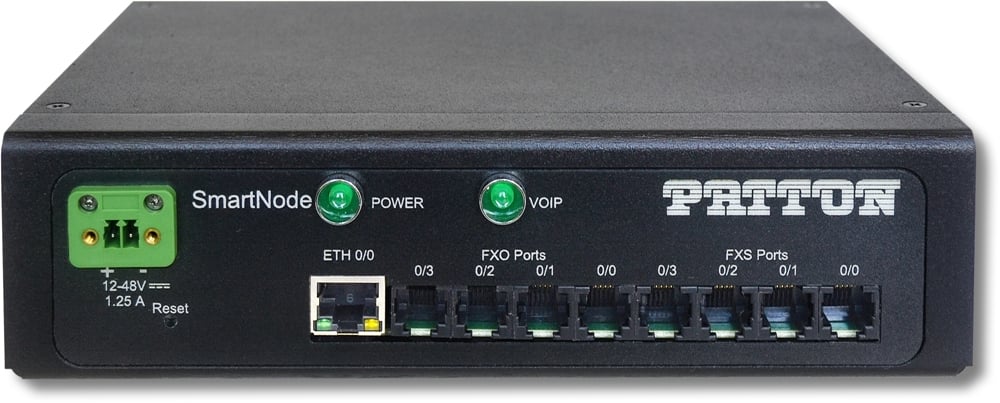
In preparation for the migration to Industry 4.0, we should pay
attention to our mission critical fixed telecommunication services in
various industrial settings. During the migration, a total and complete
refurbishment of those services and associated devices can be expensive
and/or practically very challenging. However, using ruggedized VoIP
gateways, this can be handled cost effectively in a phased, reliable,
and risk-averse manner, while reaping the benefits of an IP converged
telecommunications network that promotes safe and effective
communications.
Instead of a complete rip and replace strategy, industrial system
installers and planners can continue to use their existing ruggedized
LED strobes/beacons, industrial phones, paging systems, single- or
multi-number auto-dialers, DECT base stations, emergency phones, digital
microwave radio systems, and any other equipment that rely on FXO/FXS
interfaces. These systems are already deployed with considerable
investment in hard-to-reach outdoor locations in factory environments
and industrial complexes.
The question that arises is, “Can we maximize the existing investment
in these systems and solutions?” The answer is a resounding yes!
Ruggedized VoIP gateways will allow connection and integration of these
industrial systems and solutions to a SIP-based VoIP network and
Unified Communications solution.
We are already well acquainted with the many benefits of cloud
managed VoIP in terms of the installation, topology and the added
functionality of monitoring, software updates, management and
orchestration remotely from the cloud portal. Hence, for our discussion
and as a solution, we will consider the cloud-enabled Patton Networks SN4140E series of Industrial FXS/FXO VoIP Gateways, which can be fully managed remotely from the Patton cloud portal.
The Patton Networks SN4140E series of Industrial FXS/FXO VoIP Gateways offer:
- Up to 8 FXS (long reach) and/or FXO ports that support voice and/or fax traffic;
- SIP, T.38, supports simultaneous connectivity to multiple SIP services, interoperable with various softswitch and IP-PBX vendors;
- Supported codecs include G.722, G.711,G.723.1,G.729, 729a, 729ab, G.726;
- For network connectivity, one or two 10/100/1000 Base-T Ethernet ports;
- Management and provisioning via web interface, SNMP, CLI, full monitoring, maintenance and reporting using the Patton cloud portal;
- Ruggedized for operating temperatures between -40 to +70 °C; Vibration/Shock (IEC 60068-2-6, 7.5 mm, 5–8 Hz, 2g, 11 ms/IEC 60068-2-27, 15 g, 11 ms; humidity (85% condensing for 100% optional conformal coating is offered); electrical power input spike and surge protection (MIL STD 1275); Input power via terminal block (12–48 VDC); extended temperature external AC to DC power adapter; optional power 48V input (36–60 VDC); DIN-rail mounting clip on unit and optional shelf mounting; metal enclosure for installation in a cabinet on a DIN-rail or on a shelf.
For the interoperability and functional testing, we requisitioned the
SN4141E/2JS2V/DC SmartNode Industrial VoIP Gateway with the following
specifications: 2FXS, 2 VoIP Calls or 2 SIP-SIP calls (SIP b2b UA), 1x
Gig Ethernet, Internal 12-48 VDC and the AC/DC Desktop Power Adapter,
12V, 100-240VAC, 60W, Terminal block screw-down connector. The SN4141E
is Patton cloud enabled.
Functional Testing
We will deploy the Patton Networks SmartNode 4141E Industrial FXS
VoIP Gateway equipped with 2 FXS ports and software release version
(Trinity 3.15.1-19021) along with the following devices and systems in a
test environment (Please refer to Fig. B: Functional and interoperability testing of Patton SmartNode 4141E Ruggedized VoIP Gateway):
- DECT 6.0 Base Station and handsets,
- Grandstream Networks GXV3370 IP video phone (software release version 1.0.1.43),
- Public SIP trunk services,
- Grandstream Networks WP820 Wi-Fi phone (software release version 1.0.3.6),
- Patton SmartNode SN5570 Series eSBC running software version Trinity 3.15.1-19021, which will provide SIP registrar services and SIP demarcation from the public SIP trunk provider, while maintaining interoperability and interconnectivity,
- Grandstream Networks GWN7600 802.11ac Wave-2 Wi-Fi access point (software release version 1.0.8.18),
- Microsemi PDS-208G Digital Ceiling PoE switch (software release version 2.53)
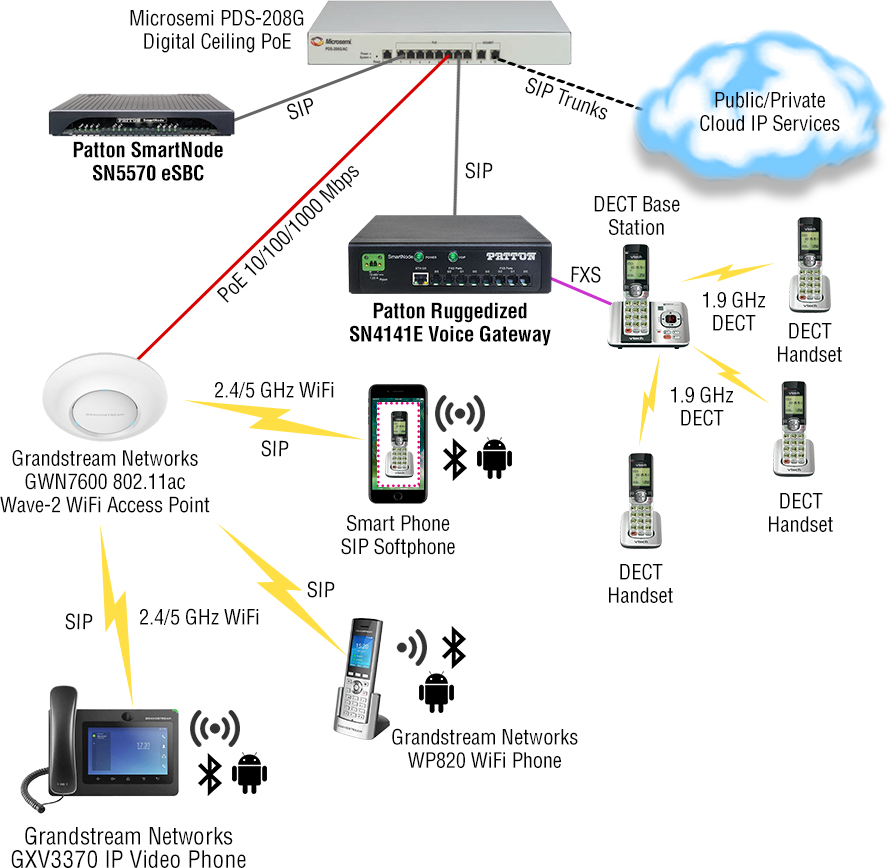
The SN4141 Industrial FXS VoIP gateway was powered using the power
adapter and was plugged into the Microsemi Digital ceiling PoE switch.
For initial management and provisioning of the SN4141E (configured
values applicable for our functional testing of SN4141E, such as, IP
parameters under Context IP, DNS, Location Service, Context SIP Gateway,
call routing and SIP interfaces, SIP interface towards the FXS port,
Context CS Switch, etc., we used the web interface shown in Fig. C Patton SmartNode 4141E Ruggedized VoIP Gateway Web Interface.
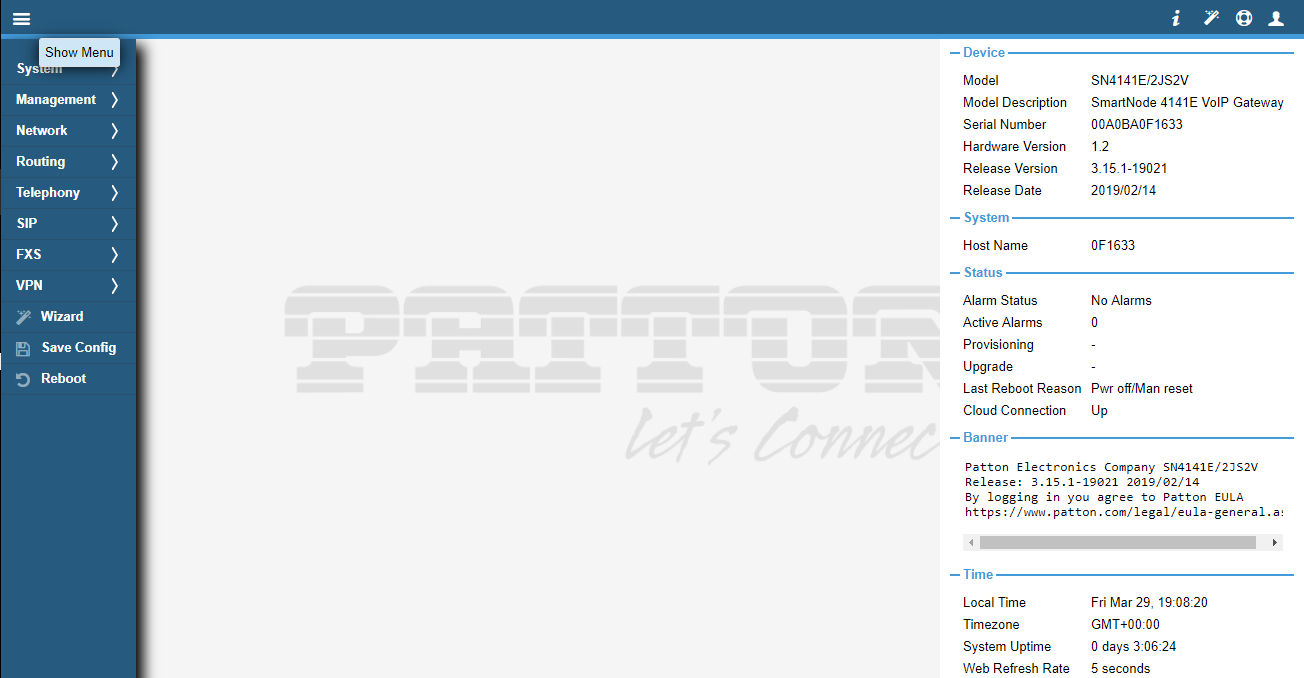
The Patton SmartNode SN5570 eSBC was pre-provisioned and fully
available on the Patton cloud portal, to provide all the test SIP
devices on-premises with SIP registrar services. The SmartNode 4141E is
installed on-premises, however, we will proceed with onboarding it to
the Patton cloud to glean the benefits of a centralized single portal
interface that permits full monitoring, maintenance and reporting from
the cloud. This required a few steps on the SN4141E, including ensuring
that the modem’s client is running, the clock is accurate, the correct
organization key is installed, and it is reachable via Internet to the
server modems.patton.io. We logged into patton.io and clicked on Devices
(shown in Fig.D Patton Cloud Devices View) to register the SN414E using its serial number.
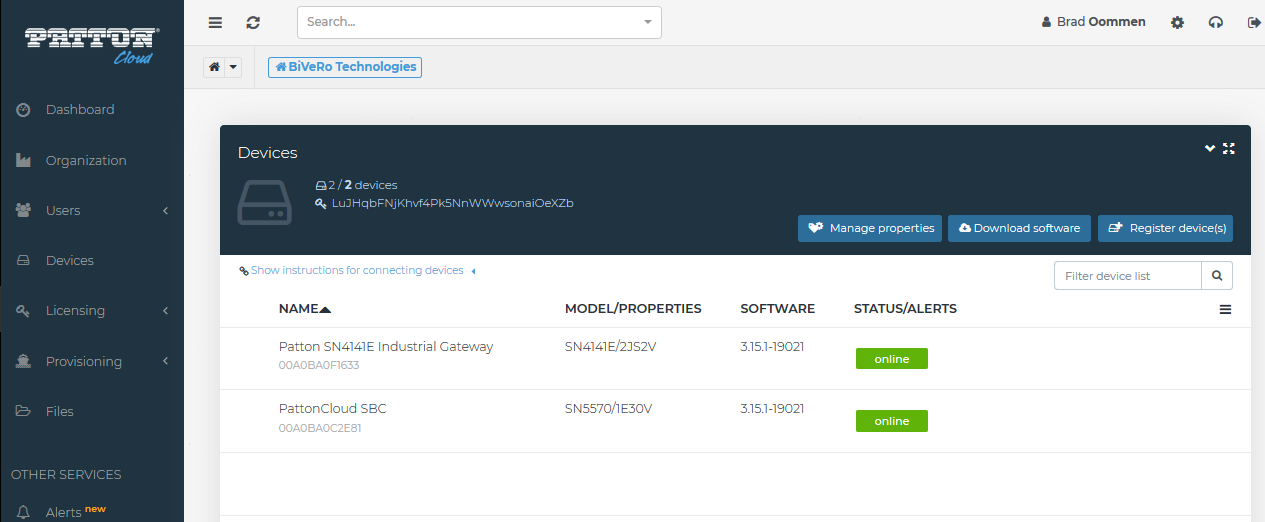
As soon as you log into the Patton cloud, you are presented a
top-level organizational dashboard view with lots of useful information.
The dashboard shows us the devices that are located, devices that are
online, device details (model, status, software, geographical location
on map, etc.). Fig. E: Patton Cloud-Organizational Dashboard View depicts the organizational Dashboard view.
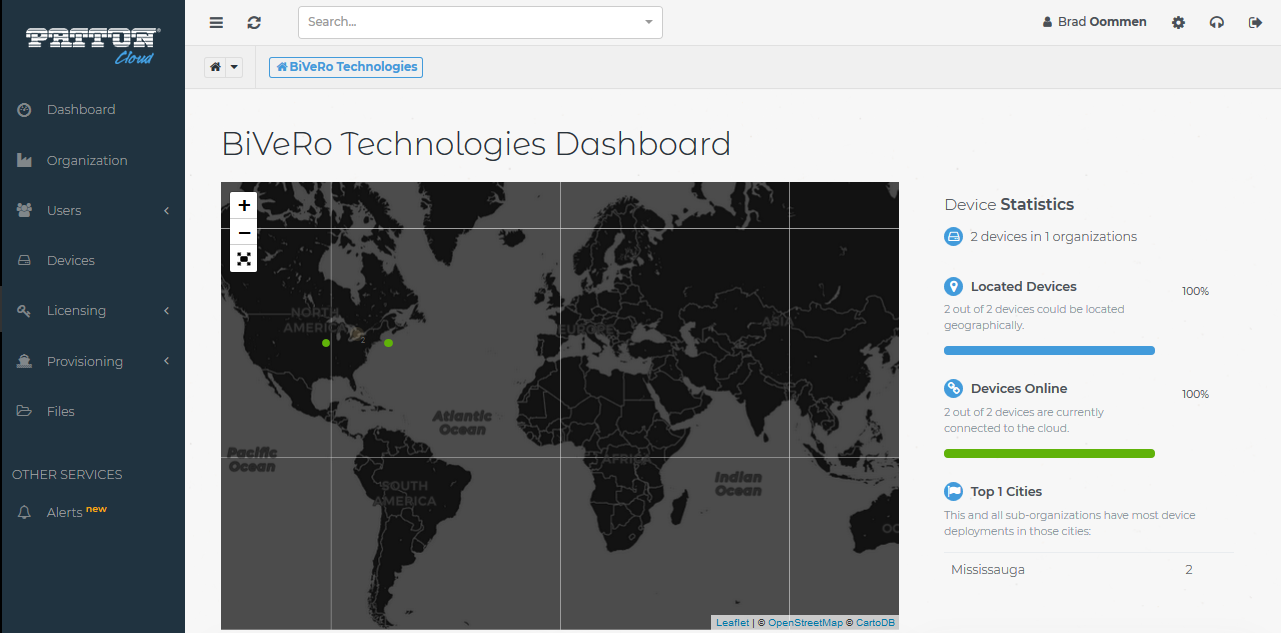

Within devices, under STATUS/ALERTS for the SN4141E, we clicked on the green online icon next to it (Fig.D Patton Cloud Devices View).
It presented us with a lot of tabular options, such as: Status, Info,
Health, Interfaces, Configs, Files, Commands, Terminal, UI, etc. You
can refer to Fig.F Patton Cloud-SN4141E Device View. Now, from one
easy-to-access location, these options gave us in-depth control,
visibility and complete insight into the configurations and operational
aspects of the SN4141E. You click on each of those respective tabs for
further action, granular information, trending graphical views, and
more. You could also click on actionable icons, such as Blink (Blink
LEDs on the SN4141E), Drop Calls (drop active calls on SN4141E), Reboot
(reboot SN4141E).

We plugged the DECT 6.0 base station to the FXS 0/0 port on the
SN4141E. Going off-hook on the DECT 6.0 handset, now we had a dial
tone. For the interoperability and functional testing, a test Wi-Fi
network was provisioned on the Grandstream Networks GWN7600 802.11ac
Wave-2 access point. The Microsemi PDS-208G Digital Ceiling PoE switch
provided PoE power. The SIP devices, Grandstream Networks WP820 Wi-Fi
phone, SIP softphone running on a Smartphone and Grandstream Networks
GXV3370 IP video phone over Wi-Fi connected to the public SIP trunks via
the Patton SN5570 eSBC.
We placed several inbound/outbound test calls from the DECT phones
and the other SIP devices on the test network while using the public SIP
trunk services via the Patton SN4141E Industrial voice gateway and the
Patton SN5570 eSBC. As part of this test setup and exercise, we also
examined the usefulness of the Patton cloud portal. For the status of
the interfaces on the SN4141E, we selected the Interfaces tab as shown
in Fig.G Patton Cloud-SN4141E Interfaces View. It showed us the details and the status of the Network Ports, IP Interfaces and Call-Control Interfaces.
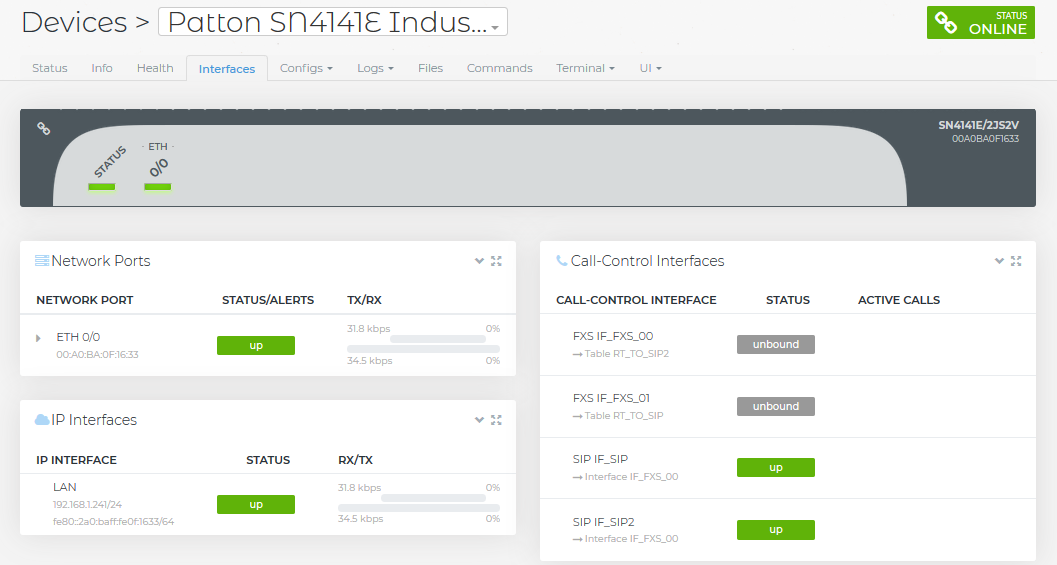
Clicking on the Device Info tab (see Fig. H Patton Cloud-SN4141E Info View)
provided us with the device serial number, model number, Software
(Active Partition, Inactive Partition, Update History, version, result),
warranty information, etc. We clicked on Active Partition Update and
we could then select the software version, reboot method
(Graceful/Forced), schedule date and time for update. Clicking on
Inactive Partition Activate presented us with: Activate secondary
image, reboot method (Graceful/Forced), schedule date and time for
activation.
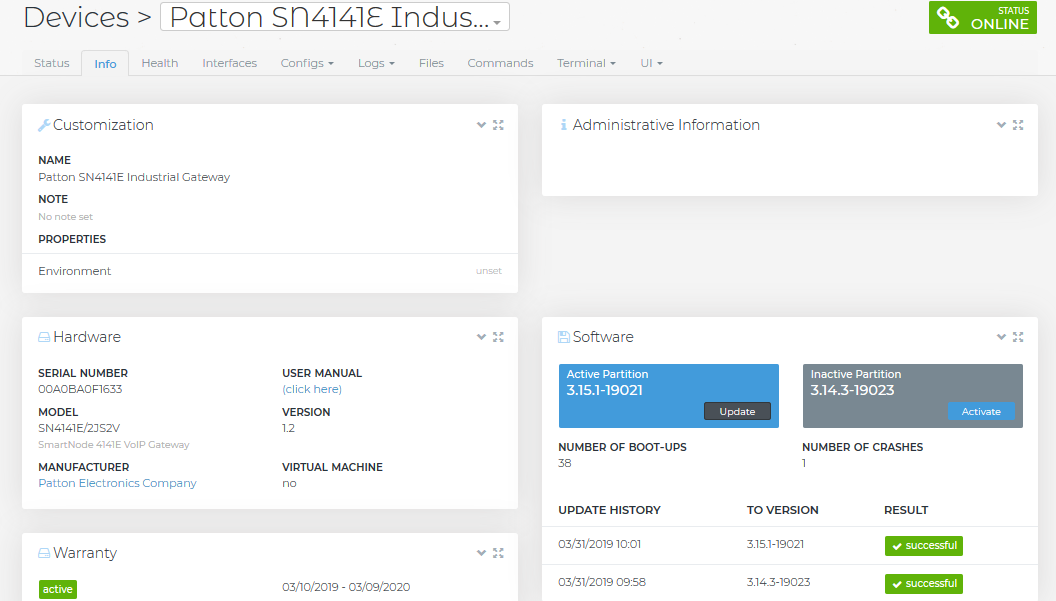
Thus, the Patton cloud, allowed control of our Patton SmartNode
industrial gateway for firmware management as we successfully completed
both an active partition update and inactive partition activate. If you
click on the Health tab (Fig. I Patton Cloud-SN4141E Device Health View),
you will note that that it shows you the CPU/RAM utilization-where you
can select graphical trends for hour, day, week and month, total calls,
ongoing calls and call rate.

Our functional and interoperability testing of the Patton cloud
enabled SN4141E industrial VoIP gateway solution serves as an
illustration of how, in a real-world industrial setting, you can easily
meet your business and voice technology migration objectives while
concurrently keeping an eye on complexity, cost and operational
efficiency.
In summary, thanks to the Patton cloud enabled SN4141E industrial
VoIP gateway, we were able to effortlessly migrate and interconnect our
test DECT system to the SIP cloud telephony systems and trunk services.
Patton cloud, an easy to use portal, adds immense value to the SN4141E
industrial VoIP gateway. Useful monitoring, full management information
and provisioning capability are just a mouse click away. We could
access the Patton cloud from anywhere, and could now orchestrate and
fully manage our SN4141E from anywhere by just using a browser.
Patton cloud is a centralized cloud management platform that provided
us with real-time data, status/alerts and report information on the
SN4141E that could span across various geographic locations without any
management server hardware or applications on-premises. All the
presented performance and operational data can help immensely with
activities such as capacity planning, troubleshooting, and optimization
of the setup.
Conclusion
During migration to Industry 4.0, there is a distinct need for a
solution such as the Patton cloud-enabled SN4141E industrial VoIP
gateway. It will simply, efficiently, reliably and cost effectively
assist with the connection and migration to modern SIP IP-based
infrastructure of existing ruggedized voice equipment and systems
infrastructure that rely on FXO/FXS interfaces.

Comments
Post a Comment